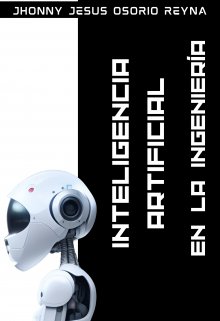https://st.booknet.com/uploads/covers/220/1708709086_66.jpg
La Inteligencia Artificial en la Ingeniería
Bibliografía
- Bishop, C. M. (2006). Pattern Recognition and Machine Learning. Springer.
- Russell, S., & Norvig, P. (2021). Artificial Intelligence: A Modern Approach. Pearson.
- Kumar, V., Minz, S., & Verma, K. (Eds.). (2020). Intelligent Computing and Communication: Proceedings of ICICC 2019 (Vol. 2). Springer.
- Moon, T. K., & Stirling, W. C. (2000). Mathematical Methods and Algorithms for Signal Processing. Prentice Hall.
- Kusiak, A. (2019). Artificial Intelligence in Engineering Design. Academic Press.
- Ang, K. H., Chong, G., & Li, Y. (2005). PID control system analysis, design, and technology. IEEE Transactions on Control Systems Technology, 13(4), 559-576.
- MacLeod, M. D. (2019). Data-driven optimization and the future of engineering. Annual Review of Chemical and Biomolecular Engineering, 10, 31-50.
- Bhatti, A. I., & Zhang, Z. (2019). A comprehensive review of data-driven optimization in chemical engineering. Processes, 7(10), 684.
- Subudhi, B. N., & Biswal, S. (2020). A comprehensive review of artificial intelligence (AI) applications in renewable energy sector. Renewable and Sustainable Energy Reviews, 119, 109604.
- Gandomi, A. H., & Haider, M. (2020). Beyond the hype: Big data concepts, methods, and analytics. International Journal of Information Management, 50, 257-269.
- Brintrup, A., Gong, L., & Tiwari, M. K. (2018). Artificial intelligence and expert systems in aerospace manufacturing: Potential and challenges. Computers & Industrial Engineering, 116, 184-197.
- Dash, S. R., & Dash, S. K. (2019). Machine learning techniques for condition monitoring of critical assets: A review. Engineering Applications of Artificial Intelligence, 87, 1-28.
- Holland, J. H. (1975). Adaptation in natural and artificial systems: An introductory analysis with applications to biology, control, and artificial intelligence. U Michigan Press.
- Goldberg, D. E. (1989). Genetic algorithms in search, optimization, and machine learning. Addison-Wesley.
- Cios, K. J., Pedrycz, W., Swiniarski, R. W., & Kurgan, L. A. (Eds.). (2007). Data mining: a knowledge discovery approach. Springer Science & Business Media.
- Chong, C. Y., & Zak, S. H. (2014). An introduction to optimization (Vol. 4). John Wiley & Sons.
- Schaefer, R., & Zimmermann, H. J. (1998). Artificial neural networks for pattern recognition: Advances in applied science and industrial applications. Springer Science & Business Media.
- Zhang, J., & Tsang, E. C. (Eds.). (2010). Evolutionary computation in dynamic and uncertain environments. Springer Science & Business Media.
- Siegel, E., & Goldenberg, J. (2016). Machine learning for healthcare: Case studies and algorithms for working with healthcare data. O'Reilly Media, Inc.
- Konar, A. (2005). Artificial intelligence and soft computing: behavioral and cognitive modeling of the human brain. CRC Press.
- Goh, C. K., Lin, Z., & Li, M. (2017). Handcrafted features versus transfer learning for plant disease classification. In 2017 IEEE International Conference on Bioinformatics and Biomedicine (BIBM) (pp. 2319-2324). IEEE.
- Beale, R., & Jackson, T. (1990). Neural computing: an introduction. CRC Press.
- Alpaydin, E. (2020). Introduction to machine learning. MIT press.
- Verma, A. K., Tiwari, M. K., & Iyer, A. (2020). A comprehensive review on application of artificial intelligence in oil and gas industry. Journal of Natural Gas Science and Engineering, 79, 103442.
- Shah, D., Dongre, K., & Ratnaparkhi, S. (2017). A review on artificial intelligence techniques in fault diagnosis of induction motor. Engineering Science and Technology, an International Journal, 20(1), 287-297.
- Suykens, J. A., & Vandewalle, J. (1999). Least squares support vector machine classifiers. Neural processing letters, 9(3), 293-300.
- Cherkassky, V., & Mulier, F. (2007). Learning from data: Concepts, theory, and methods. John Wiley & Sons.
- Lecun, Y., Bengio, Y., & Hinton, G. (2015). Deep learning. nature, 521(7553), 436-444.
- Fu, J., Zeng, Y., & Zhou, J. (2019). Application of artificial intelligence in water quality assessment based on fuzzy comprehensive evaluation method. IEEE Access, 7, 96257-96268.
- Kim, J. H., & Choi, K. S. (2020). A study on the implementation of artificial intelligence-based optimization for design development of eco-friendly concrete mixes. Sustainability, 12(3), 1081.
- Chakraborty, A., & Chattopadhyay, R. (2020). Application of artificial intelligence in predicting the critical temperature of superconductors. Journal of Superconductivity and Novel Magnetism, 33(8), 2605-2610.
- Goldberg, D. E. (2002). The design of innovation: Lessons from and for competent genetic algorithms. Springer Science & Business Media.
- Kaveh, A., & Talatahari, S. (2010). Optimum design of skeletal structures using imperialist competitive algorithm. Computers & Structures, 88(21-22), 1220-1229.
- Hagan, M. T., Demuth, H. B., Beale, M. H., & De Jesús, O. (2014). Neural network design. Martin Hagan.
- Schmitt, F. (2008). Artificial neural networks: Formal models and their applications—ICANN 2008. Springer Science & Business Media.
- Simpson, T. W., Poplinski, J. D., Koch, P. N., & Allen, J. K. (2001). Metamodels for computer-based engineering design: survey and recommendations. Engineering with Computers, 17(2), 129-150.
- Yang, X. S. (2010). Nature-inspired metaheuristic algorithms. Luniver press.
- Bengio, Y., Courville, A., & Vincent, P.

